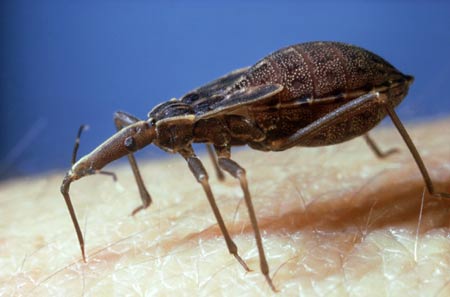|
 Chagas disease is a parasitic infection transmitted by blood-sucking insects, largely in impovershed areas. |
|
Experts have dubbed it the “new AIDS of the Americas.” A parasitic infection called Chagas Disease has similarities to the early spread of HIV, according to research published recently in the journal PLoS Neglected Tropical Diseases. Like AIDS, Chagas is hard to detect and has a long incubation period before symptoms emerge, the study said, according to the New York Times. As many as 8 million people are infected in the Western Hemisphere, mainly in Bolivia, Mexico, Colombia and Central America, as well as some 30,000 people in the US, the newspaper reported. Chagas infects people in areas of poverty, and most US cases are found in immigrants. Because Chagas is often left untreated, it spreads easily, either genetically or through blood transfusion. If caught early, it can be treated with intense medication, but the drugs are scarce in poor countries and very little money is invested in searching for new treatments, the paper said. Chagas is usually transmitted from the bite of blood-sucking insects that release a parasite called Trypanosoma cruzi into the victim’s bloodstream. The parasite can eventually make its way to the heart, where it can live and multiply. Infections often stay dormant for years, and then emerge as heart arrhythmias and heart failure. About a quarter of victims develop enlarged heart or intestines that can lead to sudden death if they burst, according to the Centers for Disease Control and Prevention. New research suggests Chagas may have led to the death of Charles Darwin — one of the great medical mysteries. Researchers from the University of Maryland School of Medicine believe Darwin suffered from three different illnesses, including a Chagas infection contracted on a voyage to the Andes in South America, the Wall Street Journal reported earlier this month. Darwin wrote in his diary that he was bitten by a “great wingless black bug” during the trip in 1835. He died 47 years later of heart failure. (Read by Brian Salter. Brian Salter is a journalist at the China Daily Website.) (Agencies) |
專家將其稱為“美洲的新艾滋病”。 根據《PLoS被忽視的熱帶疾病》期刊近日發布的研究稱,這種名為“查加斯病”的寄生蟲傳染疾病和艾滋病早期的傳播過程具有相似性。 根據《紐約時報》,該研究稱,查加斯病就像艾滋病一樣難以覺察,而且在出現癥狀前有一段長時間的潛伏期。 據《紐約時報》的報道,在西半球已有800萬人感染了這一疾病,患病者主要分布在玻利維亞、墨西哥、哥倫比亞和美洲中部,在美國也有3萬人感染此病。查加斯病在貧民區的人群中間傳染,許多美國患者都是外來移民。 據報紙的報道,因為查加斯病常常得不到治療,因此它很容易就通過遺傳或輸血散播開來。如果在疾病早期發現,可采用密集藥物治療方法,但窮國的藥品很稀缺,在尋求新療法上投資也很少。 查加斯病通常是通過吸血昆蟲的叮咬、將被稱為克氏錐蟲的寄生蟲輸入受害者血液中進行傳播。這種寄生蟲最后會到達心臟,在那里生存和繁殖。 根據美國疾病控制與預防中心,這種傳染病通常會潛伏數年,然后以心律失常和心臟衰竭的形式發作。約有四分之一的受害者會發展成心臟或腸道擴大,如果發作可能導致猝死。 新研究顯示,查加斯病可能是查爾斯?達爾文的死因——達爾文的死是史上最大的一個醫學之謎。 根據《華爾街日報》本月早些時候的報道,馬里蘭大學醫學院的研究人員認為,達爾文死前患有三種不同的疾病,包括去往南美安第斯山脈航海旅途中染上的查加斯病。 達爾文在他的日記中寫道,1835年他在旅途中被一只“巨大的沒有翅膀的黑色昆蟲”咬了。47年后他因為心臟衰竭而死。 相關閱讀 (中國日報網英語點津 陳丹妮 編輯:Julie) |
|
Vocabulary: incubation period: 潛伏期 dormant: 休眠的;潛伏的 heart arrhythmias: 心律失常,心律不齊 |
